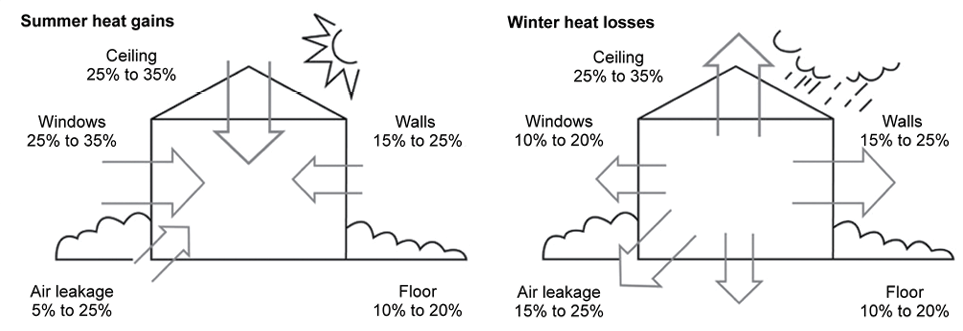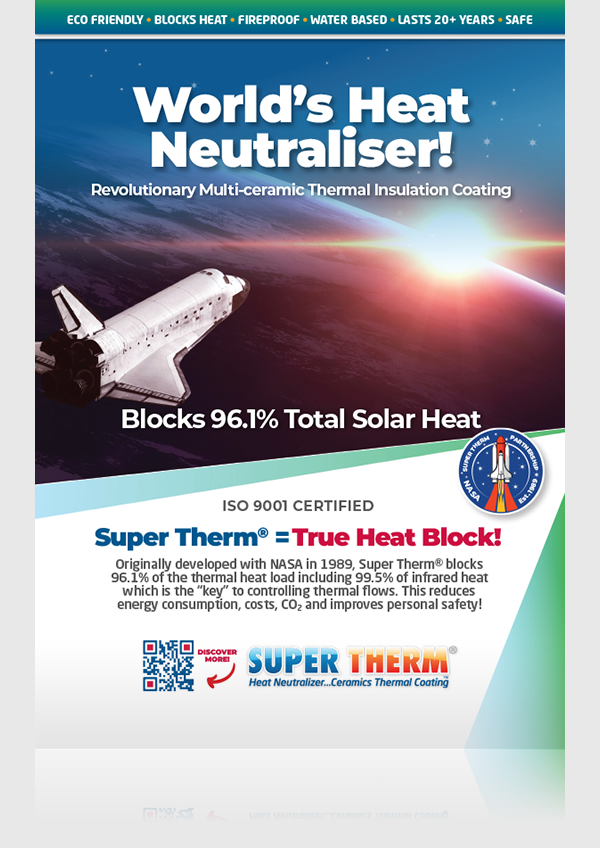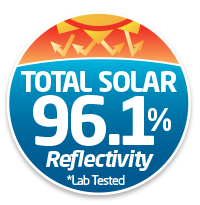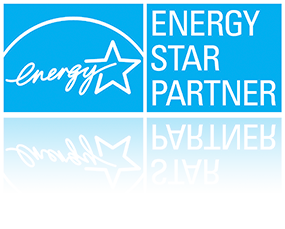Passive Ways How To Keep Your Home Cool
Flush Out Hot Air in the Evenings
Traditional bulk insulation traps hot air from the day and releases it into the home at night. If you don’t have Super Therm solar heat block coating. One thing we recommend is a ‘night flush’. Open your windows at night and circulate the fresh, cooler night air inside with ceiling fans. Then in the morning, shut your windows and blinds to trap that cool air in, and then you can start the day off at a much lower temperature and more cost effective to run than an air conditioner.
7 reasons to apply a Super Therm cool surface and roof coating system on your building
Passive cooling – more >
Australian Government | Your Home
To be comfortable, buildings in all Australian climates require some form of cooling at some time of the year. There are many ways you can design or modify your home to achieve comfort through passive (non-mechanical) cooling, as well as hybrid approaches which utilise mechanical cooling systems.
The most appropriate passive cooling strategies for your home — including orientation, ventilation, windows, shading, insulation and thermal mass — are determined by climate, so first identify your climate zone by reading Design for climate. You can then apply the more detailed advice here and in Passive solar heating.
All Australian climates apart from tropical (Zone 1) require some form of heating in winter, and this affects advice relating to cooling. The balance between summer cooling and winter heating should be adjusted for climate through appropriate passive design. Tropical climate buildings, which require year round shading and are subject to very different passive cooling principles, are discussed separately below.
The advice in this article applies to most types of residential housing; however, additional useful tips can be found in Buying a home off the plan, Buying an existing home, Renovations and additions and Buying and renovating an apartment. More >
Australian Government’s Nationwide House Energy Rating Scheme (NatHERS)
To be effective, passive cooling needs to cool both the building and the people in it – Australian Government. According to the Australian Government, a 7 star rating is achievable with basic inexpensive materials such as aluminium windows and single glazing when the right design principles are applied—such as passive design and appropriate use of insulation and material selection.
The Building Code of Australia doesn’t take into consideration new and next generation heat block technology such as Super Therm® that blocks the heat entering the structure. NatHERS say in order to achieve a 7 Star rating building you need a roof colour of Surfmist® in Adelaide, Brisbane, Canberra, Darwin, Sydney and Windspray® in Melbourne and Hobart (Colorbond® products).
The summer heat in Melbourne can exceed 40° so to have a near 50% grey roof (Windspray®) as a specified colour for a hot environment isn’t energy efficient. Interestingly Surfmist® is the lightest colour in the Colorbond® range above and is recommended for the rest of the country except Perth that has Classic Cream®.

Top 10 tips to keep your home cool
Try these simple strategies to beat the heat and save on energy bills – more >
Setting your air conditioner to arctic might seem like the best way to beat the heat, but it can blow out your energy bill and increase wear and tear on the air conditioner’s motor.
You’ll generally get better efficiency from your air conditioner if you aim for a maximum temperature differential (the temperature difference between inside and outside your home) of around 8°C. So on a 32°C day, set your air conditioner to no more than 24°C.
On scorching days, most people will still want a cooler temperature, but for maximum energy efficiency, try not to go too far beyond the 8°C difference – each degree cooler adds about 10% to your air conditioner’s running cost.
Your air conditioner will be more efficient and effective if you give it some love, like cleaning the filter and ensuring the outside motor is well shaded. More >
10 energy efficient ways to cool your home
With these cost- and energy-efficient cooling solutions, beating the summer heat is a breeze. More >
When it’s a real scorcher outside, turning the aircon on is one way to provide relief. But there are several things you can do to keep running costs down.
“Close doors so you’re only cooling the rooms you’re using, and shade the windows,” says Dr Robert Simpson, energy-efficiency specialist at Ausgrid. “Set the aircon between 23˚C and 26˚C – each degree of extra cooling can add 10% to your running costs.”
You can help the machine run more efficiently by shading the outdoor unit and keeping filters clean.“Regularly cleaning and servicing can help reduce your energy bills by up to 30 per cent,” says Andrew Foard, seasonal buyer at The Good Guys. More >
Build an Eco-Friendly Home
If you’re building or renovating, now is the time to implement strategies to reduce your reliance on artificial cooling.”
“A well-designed home will use passive cooling features such as insulation, aspect and shading to prevent heat entering and reduce energy bills,” says Dr Simpson. “Insulation can keep a house seven degrees cooler in summer and reduce energy costs by up to a third. Insulating your ceiling and roof are the most important.”
Incorporating ceiling vents to expel hot air from the roof cavity will also help, adds Kim Runje, building supplies manager at Bunnings. Position your doors and windows where they will take advantage of cooling breezes, and consider double- or triple-glazed windows in well-sealed frames to even out temperatures. More >
The 18 Best Ways to Keep a House Cool Without AC. More >
There’s nothing like walking out of a summer heat wave and into the frigid comfort of air conditioning. But for some homes, especially those built before the 1950s, AC isn’t an option. So how do you keep a house cool in the summer without air conditioning? The answer: summer-proof each floor, one by one. Here are the 18 best ways to keep your house cool without AC, from top to bottom – starting with the attic.
“Your attic is typically 20 to 30 degrees hotter than the rest of your home. If there’s not enough venting, it’s going to trap a lot of hot air which can heat up your entire home. Use an attic fan to improve ventilation.” Scott Trento | QuietCool Whole House Fans
Opt for a White Roof
On a sweltering day, traditional black roof materials can become over 38°C hotter than the air around them. A white roof can be a great way to keep your house cool in the summer because it reflects heat instead of absorbing it, keeping the warmth from seeping into the rest of your home. You can install white roof panels or apply white roof coating if you have a flat or metal roof. More >
Can you cool a house without air conditioning? More >
As global summer temperatures rise, more buildings are installing energy-hungry air conditioners – a major contributor to climate change. But are there ways to cool buildings down without turning the AC on?
At first sight, the view could be mistaken for the rolling hummocks of Hobbiton, right down to the perfectly circular doors opening out of the lush green hillside. But the doors are made of glass, and inside them are not cosy hobbit holes but an array of large mechanical steel arms and levers holding some of the doors ajar.
These hills are part of the roof of the California Academy of Sciences in San Francisco, US. The undulating green roof is one of a series of engineering and design features that make the academy one of the largest passively ventilated spaces in the US. This means that even in the peak of summer, the bulk of this building relies on clever manipulation of the elements to stay cool, with next to no air conditioning. More >
15 Brilliant Ways To Keep Your Home Cool Without Air Conditioning. More >
In warmer months, it’s tempting to crank the AC or plant yourself in front of the nearest fan. But these aren’t the only tricks to keeping cool. It turns out there are plenty of ways to buffer your home from the heat without racking up your electric bill. And they’ll make you feel like a DIY champ, too. More >



























